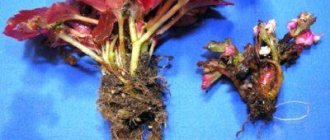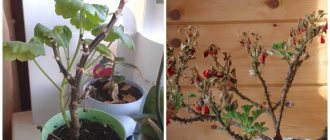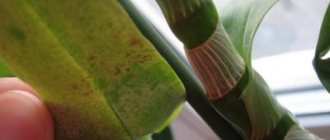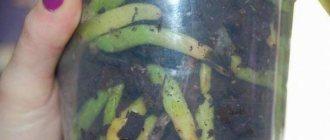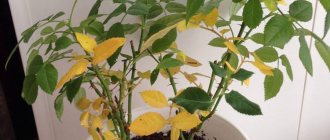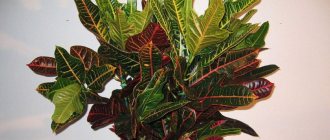Why do begonia leaves turn black?
If the tips of the leaves dry out and turn black, this indicates insufficient watering. Begonia is a tropical plant and loves moisture. This plant needs to be watered so that the ground is slightly moist: in summer - 2 times a week, in winter - no more than once. In the hottest weather, begonia needs to be watered every day.
Interesting materials:
How to remove old sealant from plastic windows? How to remove old sealant in a shower stall? How to remove old sealant in the bathroom? How to remove old sealant? How to remove old adhesive from tiles? How to remove old adhesive from tiles? How to remove old glue from the floor? How to remove old glue from walls? How to remove an old printer from a computer? How to delete an old pass?
Reason 1. Drying the soil
As soon as begonia stops receiving moisture and nutrition from the root system due to the fact that the earthen ball is too dry, its leaves turn pale, lose turgor (elasticity), and begin to shine glossy.
Unfortunately, this situation is familiar to me. A couple of times I dried my plantation of young cuttings, and saw how the healthy, green bushes the next day, without exception, were all pale, limp and painfully shiny.
After watering, the situation partially returns to normal. New leaves grow healthy and less affected ones also come to their senses.
And severely damaged ones either remain shiny with dry edges, or dry out completely. It all depends on how damaged a particular leaf is.
The root system also suffers severe damage from drying. Thin roots dry out and die, and after abundant watering they can begin to rot!
Therefore, it is very advisable to avoid drying out at all, and if it does occur, do not immediately water it abundantly!
We water a little so that the plant regains its turgor. And then watering as usual, very careful and adequate.
If, after such a one-time drying, the begonia grows new green shoots and other leaves have recovered, you can exhale. She was not seriously injured and will live.
If drought conditions are constant, then such a swing from dryness to humidity will naturally lead to the death of the root system.
If you think that you did not dry the plant and this cannot be the reason for its poor health in your case, then see the next point.
Begonia: leaf diseases, photos, how to treat.
The main wealth of the group of leaf begonias is the pubescent leaves that appear immediately from the root. They can be not only green, but also red, yellow, white, silver and even brown, and have a variety of shapes, borders and multi-colored spots. Diseases can irreparably disrupt this splendor.
Spots and yellow rings on leaves
Begonia diseases and pests photos
Such manifestations of begonia disease and subsequent deformation of the leaf blades indicate a cucumber mosaic virus, against which there are no methods of combating. All that remains is to eliminate the diseased plant as quickly as possible in order to stop the further spread of the infection.
Gray mold
It is also called gray rot. First, the leaves become covered with wet white spots with a gray coating. Subsequently, the leaf blades turn black and dry out. The cause of this begonia disease is the Botrytis fungus, the appearance and reproduction of which is promoted by dampness, which should be removed urgently. Affected areas of the plant will have to be removed. If the disease is just beginning, you can try to limit yourself to treatment with Bordeaux mixture (1 percent solution) or an aqueous mixture (1 l), laundry soap (20 g) and copper sulfate (2 g). If the result is negative, Fundazol and stronger antifungal fungicides are used - Topsin, Euparen, Polycarbacin, BMK, Rovral.
Powdery mildew
The onset of this fungal disease of begonias can be recognized by round plaques of white, flour-like plaque, which then spreads to all the leaves, which turn brown and dry out. The reason is excessive saturation of air and soil with moisture, high temperature.
Control measures include processing:
- Foundationazole (0.1% solution);
- a liquid of copper sulfate (2 g), tar soap (20 g) and water (1 l);
- ground or colloidal sulfur;
- you can use Fitosporin, Alirin-B, Planriz;
- In particularly difficult cases, use Strobin and Topaz.
Black root rot
When plants stop growing and wilt, be sure to look at the condition of the roots. If they turn black and begin to rot, there are symptoms of black root rot - a disease that appears under conditions of excessive watering. Removing diseased roots and spraying with Benomyl will help to cope with it.
Useful tips
Professional gardeners give the following useful recommendations for keeping begonias:
- For irrigation, take well-settled or filtered water at room temperature. It can be acidified to make it softer. In cold weather, watering is done with warm water and only when the soil is dry.
- It is advisable to periodically loosen the soil to a depth of about 1 cm to improve the supply of oxygen.
- The room should be regularly ventilated to provide fresh air, but without drafts for plants.
- Deciduous begonias should properly organize a dormant period in the fall.
- The pot with begonias should be placed on a well-lit side, but without direct sunlight, which can cause burns.
- Provide the required level of humidity. To do this, carry out small sprays using a spray bottle. It should be noted that the air near the begonia is sprayed so that moisture does not fall on the leaves - this can cause brown spots to appear. To maintain humidity when the room is dry, it is recommended to place a container of water near the flowerpot or place the pot in a tray with wet pebbles.
- Regularly fertilize the vegetating plant.
- When replanting, use loose nutrient soil with a pH of 5.5–6.5. You can buy ready-made soil for begonias, or you can make a soil mixture based on leaf soil, peat, sand and humus.
- Watering should be done in moderation so that the water does not stagnate in the pot, as this leads to the appearance of many fungal diseases. It is recommended to water at the same time in the morning. During the period of ovary and flowering, the plant should be watered more abundantly.
Find out more about the features of growing such types of begonia as: coral, mason, elatior, ever-flowering, royal, cleopatra, red-leaved, tiger.
Organizing care for begonia in such a way that its leaves do not wither is easy, even for a beginner. You just need to spend a little time, and your plant will delight you with its blooming appearance.
Diseases due to pests and their destruction
Begonia is affected by a variety of pests.
- Spider mite. The leaves become dull, lose color, begin to fade, and cobwebs appear on the lower surface. Treatment with systemic insecticides will solve the problem.
- Nematodes. Their appearance will be indicated by swellings on the roots and lifeless leaves. It is better to destroy the plant immediately.
- Aphid. If the infection is severe, all leaves and buds may fall off. The plant will be saved by treating it with an insecticide and a strong soap solution.
- Greenhouse whitefly. Small white butterflies feeding on plant sap. 40 g of laundry soap dissolved in 10 liters of water will help destroy the pest. Leaves with eggs and larvae must be destroyed before processing.
Whitefly on begonia
- Greenhouse thrips. The plant loses its decorative effect, becomes faded, lifeless, and sheds its leaves. You can fight it with a soap solution or insecticides.
- False shield. The presence of a pest can be judged by the appearance of the insects themselves (brown scales) and sticky products of their metabolic activity on the leaves. The fight against scale insects is not easy, since the pests are protected by shields. A combination of mechanical removal with a brush and treatment with an insecticide will give the result.
Note! Most diseases of domestic begonia are provoked by an unsuitable microclimate, which appears as a result of improper, inappropriate care. The first step in the treatment of such diseases should be a revision of agricultural practices and methods.
Traditional methods of pest control
A folk method for getting rid of aphids and spider mites: chop 15 g of onions and leave in 1 liter of water for about a week. Treat the damaged begonia with the strained solution every five days until the pests are completely destroyed.
An infusion of shag mixed with celandine juice will help against thrips and aphids.
Aphids on leaves
The false scale insect will be destroyed by an alcohol solution with soap: 15 g of liquid soap, 10 ml of alcohol and 1 liter of warm water. The solution is very aggressive, therefore, in order not to burn the plant, you need to conduct a sensitivity test on a separate leaf.
Begonia is a whimsical plant and is not easy to grow. However, if you study and follow the rules of care and maintenance, then begonia will delight you with the beauty of its flowers and foliage for a long time.
Irrigation filter Karcher
666 ₽ More details
Hose Karcher “PrimoFlex”, 1/2″, 20 m. 2.645-138.0
1269 ₽ More details
Karcher high pressure washers
Traditional methods of treating certain diseases
You can save begonia from pests using folk remedies. The most effective solutions:
- Infusion of tobacco. To prepare, you need to dilute 30 g of tobacco dust in 5 liters of warm water. The concentrate must infuse for 7 days. Watering is carried out at the root.
- Green soap concentrate. 30 g of laundry soap is dissolved in 2 liters of warm water. Any plant residues are added to the resulting solution. The tincture is prepared within 10-12 days. For treatment, begonia is sprayed with the resulting composition.
- Infusion of onion or garlic. Finely chopped onion or garlic (200 g) is infused in 5 liters of warm water for 7-10 days. The resulting preparation is diluted with water in proportions of 1:10 and filtered. For sprinkling, a fine spray is used.
Begonia classic
Compliance with the measures for growing and caring for begonia will lead to a positive result. Even if it is not possible to protect the plant from the disease, treatment will help save the flower from death. Timely watering, proper lighting and protection from harmful insects will turn the flower into a home decoration.
Reason 2. Severe damage, death of the root system
If the root system is in poor condition, then it cannot normally transfer moisture and nutrition to the above-ground part.
The same thing happens with drying. The symptoms are the same.
The same thing happens - the leaves begin to shine, turn pale in places, and dry out the edges. And this problem can no longer be solved by watering!
And certainly no “poultices”, spraying with various zircons, epines, etc. will help begonias.
Most flower growers, seeing such symptoms, frantically begin to look for the problem somewhere outside.
They spray against pests (however, this doesn’t hurt), they are susceptible to drafts, diseases, some viruses, or even just the capriciousness of the flower.
But for some reason no one thinks to “look at the root,” that is, take the plant out of the pot and analyze its root system!
For some reason, everyone thinks that there, in the depths of the pot, everything is a priori normal. And, by the way, this is where almost all the problems of the Elatiors begin!
And here is the first example.
My plant in the photo a week ago was a beautiful flowering bush, healthy and beautiful.
But such a nuisance happened that the pot with it fell from the rack due to my crooked hands.
Well, having collected the earthen soil, grumbling, I returned it to its rightful place, because I did not see any external damage.
But my bush began to grow suspiciously weak. A glossy shine appeared, in some places the leaves had some thinning, the edges were drying out, some leaves turned pale.
As always, at first I thought that I had forgotten to water it or had not watered it enough. My soil is very loose, so it dries out in two days, but after 3 days the pots are already in the Sahara Desert.
Some people pour from the heart, but I have the other extreme.

